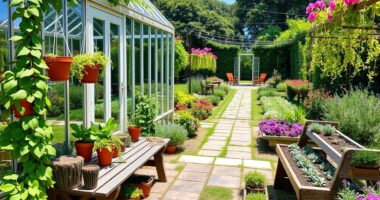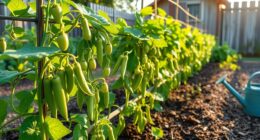Integrating a greenhouse into my garden has transformed my growing experience. I've found that selecting compatible plants boosts growth and yields. Incorporating adjustable vents enhances airflow, creating ideal conditions for my plants. I love how unique designs, like the Jocisland hexagonal greenhouse, add visual interest and function. Planning for maintenance and smart ventilation has also made upkeep easier. There are even budget-friendly DIY options out there. Discover more ways to create a vibrant ecosystem in your garden!
Key Takeaways
- Position the greenhouse to maximize sunlight exposure while complementing existing garden features for an aesthetically pleasing integration.
- Use raised beds inside the greenhouse to minimize maintenance effort and enhance accessibility for planting and harvesting.
- Implement crop rotation and companion planting strategies within the greenhouse to improve soil health and maximize space efficiency.
- Incorporate natural elements, such as trellises or green walls, to enhance visual interest and promote biodiversity in your garden ecosystem.
- Ensure proper ventilation through adjustable windows and vents to maintain ideal temperature and humidity levels for healthy plant growth.
ANGAR Garden Covers for Raised Beds
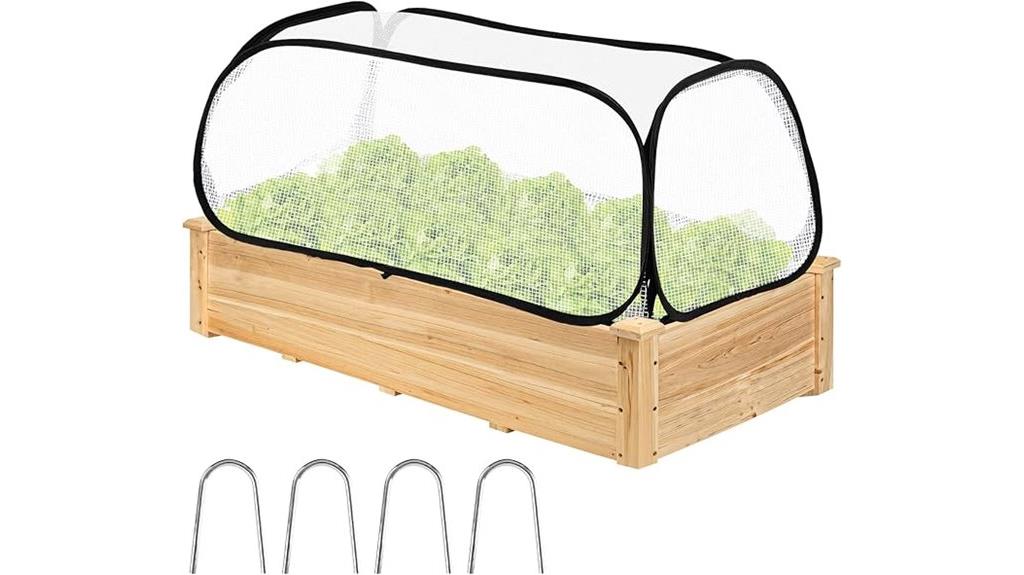
If you're looking to protect your seedlings and enhance your garden's yield, the ANGAR Garden Covers for Raised Beds are a fantastic solution. These covers measure 45in x 22in x 16in and include everything you need: a greenhouse cover, garden staple stakes for stability, and a handy storage strap. Made from high-quality PVC and breathable mesh, they block cold air while allowing for ventilation. I love how easy they are to install—just unzip and zip up! Plus, they fold down to a compact size for storage. They truly make a difference in nurturing fragile plants and ensuring healthy growth.
Best For: Gardeners looking for effective protection for their seedlings and plants from cold weather and pests.
Pros:
- High-quality materials provide durability and protection against cold air while allowing for ventilation.
- Easy installation with a simple zip design, making it user-friendly for all gardeners.
- Compact storage capability, folding down to a small size for off-season use.
Cons:
- Some users may find it challenging to fold back to its original compact size after use.
- The size may not fit larger raised beds, limiting its use for bigger gardens.
- Limited color options may not appeal to all aesthetic preferences in garden design.
Greenhouse Gardening for Beginners: Build Your Own Greenhouse and Grow Organic Vegetables, Fruits, Herbs, and Flowers
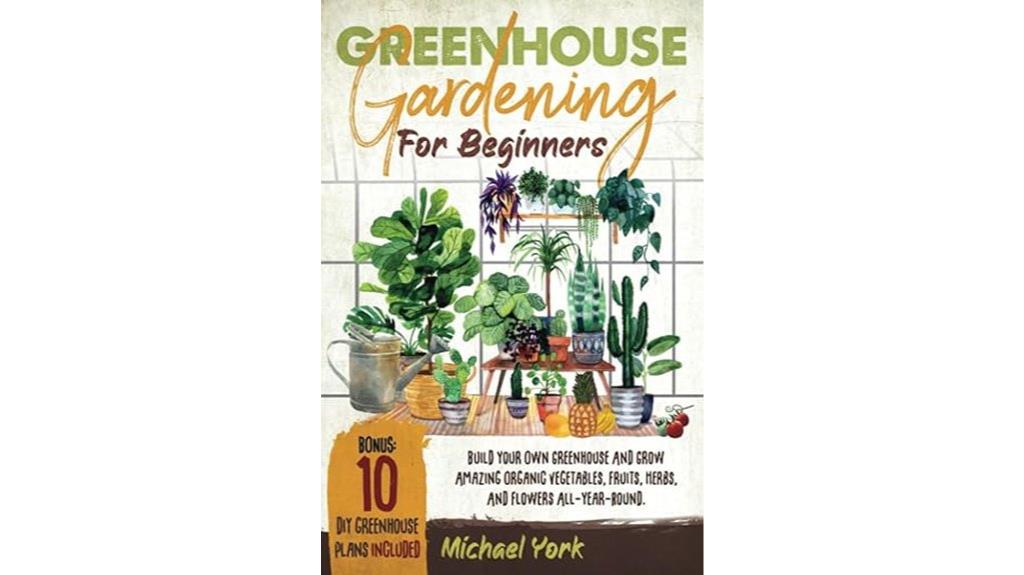
For anyone enthusiastic to immerse themselves in greenhouse gardening, "Greenhouse Gardening for Beginners" by Michael York stands out as the perfect guide. It offers clear, step-by-step instructions to build and maintain your own greenhouse, making it accessible even for beginners. I love the year-round planting calendar, which helps me schedule my crops effectively. The book also features budget-friendly DIY projects, aiming to maximize my gardening experience without breaking the bank. Plus, it touches on the potential for growing organic produce as a sustainable business, which excites me about the possibilities. This resource truly inspires me to immerse myself in greenhouse gardening!
Best For: Beginners and experienced gardeners looking to build and maintain a greenhouse while growing organic vegetables, fruits, herbs, and flowers.
Pros:
- Provides clear, step-by-step instructions for building and maintaining a greenhouse.
- Includes a year-round planting calendar and budget-friendly DIY projects to maximize gardening efforts.
- Offers insights into turning greenhouse gardening into a sustainable business opportunity.
Cons:
- Focuses heavily on greenhouse construction, which may not appeal to those seeking in-depth gardening techniques.
- Some readers may find the content less comprehensive for advanced gardening strategies.
- Limited information on specific plant care beyond initial setup and management.
The Complete Beginners Guide to Greenhouse Gardening

Integrating greenhouses with your garden is perfect for those enthusiastic to elevate their gardening game year-round. I found "The Complete Beginners Guide to Greenhouse Gardening" incredibly helpful. It breaks down greenhouse types and shows how to extend your growing season. Richard Bray covers everything from construction to pest management, ensuring I avoid common pitfalls. The plant compatibility section is a treasure, guiding me on crop rotation and fertilization. Plus, the practical charts made it easy to determine which crops thrive in my area. This guide is a must-have for anyone wanting a successful greenhouse experience!
Best For: Beginners and experienced gardeners looking to enhance their gardening skills and extend their growing season year-round.
Pros:
- Comprehensive Coverage: The guide includes detailed information on greenhouse construction, plant compatibility, and pest management.
- Practical Tools: Features practical charts and calculations to help determine suitable crops for various climates.
- Inspiration for All Levels: Well-received by both new and seasoned gardeners for its clarity and motivational approach.
Cons:
- Potential Overwhelm: The extensive information may feel overwhelming for absolute beginners.
- Limited Aesthetic Focus: Those seeking design inspiration or aesthetics in greenhouse gardening may find it lacking.
- Varied Regional Suitability: Some techniques or crop suggestions may not be applicable in all growing zones or regions.
Black & Decker Complete Guide to DIY Greenhouses, 2nd Edition
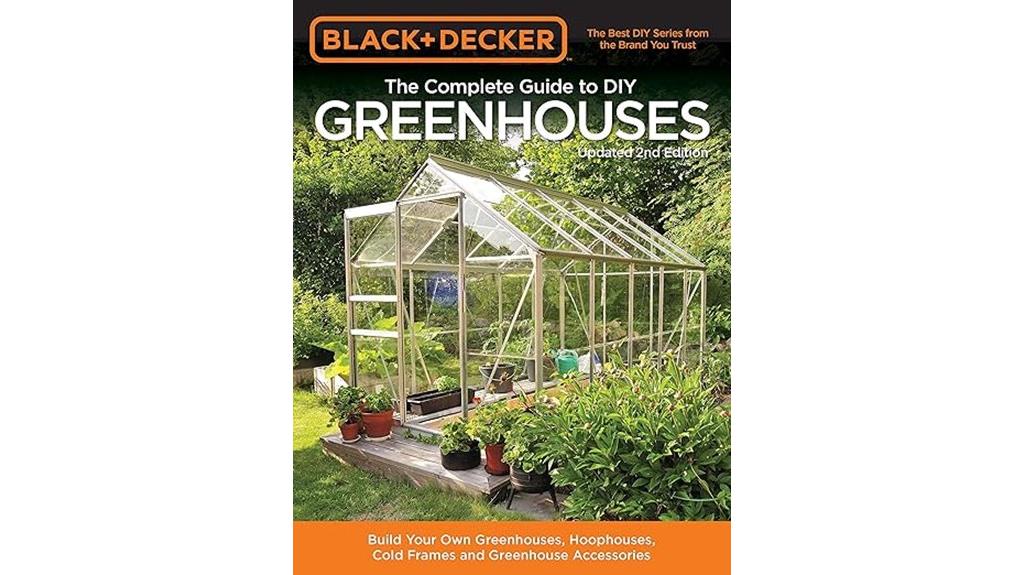
The "Black & Decker Complete Guide to DIY Greenhouses, 2nd Edition" is ideal for anyone enthusiastic to transform their gardening experience with a personalized greenhouse. This all-encompassing guide walks you through building greenhouses, hoophouses, and cold frames, providing practical advice and detailed plans. I found the extensive color photography particularly inspiring as it helps visualize potential designs. Users rave about its clarity and thoroughness, making it a top resource for both beginners and seasoned gardeners. Just remember to double-check dimensions; accuracy is key! Whether you're starting small or planning a larger project, this book's got you covered.
Best For: The "Black & Decker Complete Guide to DIY Greenhouses, 2nd Edition" is best for gardening enthusiasts looking to build personalized greenhouses, hoophouses, or cold frames.
Pros:
- Comprehensive guidance on various greenhouse designs and construction techniques.
- Extensive color photography that inspires and helps visualize potential setups.
- Practical advice and detailed plans suitable for both beginners and experienced gardeners.
Cons:
- Some users reported inaccurate dimensions in specific projects, necessitating double-checking.
- May be overwhelming for complete beginners due to the wealth of information.
- Limited focus on specific plant care within greenhouses, as it mainly emphasizes construction.
Jocisland Hexagonal Greenhouse for Outdoors
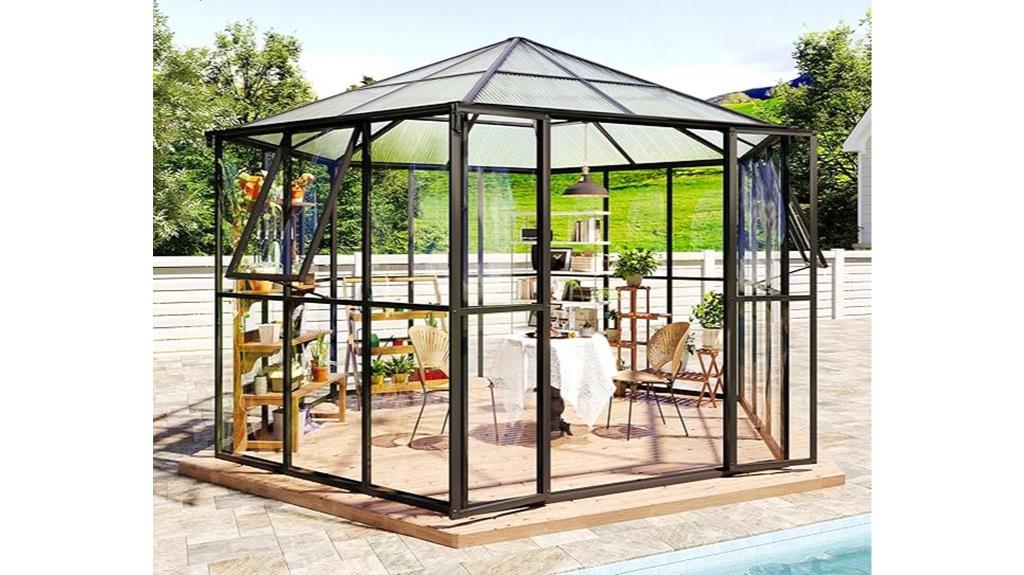
Looking to enhance your garden or courtyard? The Jocisland 12x10x8 FT Hexagonal Greenhouse might be just what you need. Its unique hexagonal design not only complements your greenery but also offers ample space for multifunctional use—think plant room or cozy dining area. With a lightweight aluminum frame, it's durable and easy to install with quick-connect adapters. The adjustable vents and translucent roof panels guarantee your plants get the right airflow and light while staying protected. Plus, the built-in gutter system takes care of water drainage. It's truly a worthy investment for any backyard enthusiast!
Best For: Garden enthusiasts looking for a stylish and functional greenhouse to enhance their outdoor space.
Pros:
- Unique hexagonal design that enhances the aesthetic appeal of any garden or courtyard.
- Durable aluminum frame that is lightweight yet robust, ensuring longevity in various weather conditions.
- Ample indoor space allows for versatile use, such as a plant room, dining area, or study.
Cons:
- Requires assembly by a team, which may be challenging for some individuals.
- Relatively high initial investment compared to traditional rectangular greenhouses.
- Limited customer reviews, which may make potential buyers hesitant about its performance.
Spacious and Durable 6×8 FT Polycarbonate Greenhouse for Outdoors

If you're searching for a greenhouse that combines spaciousness with durability, the 6×8 FT polycarbonate model is a fantastic choice for outdoor gardening enthusiasts. Its heavy-duty polycarbonate panels and rust-resistant aluminum frame guarantee it withstands various weather conditions. I love how quick and easy the setup is—its innovative design boosts installation speed by 40%, giving me more time to tend to my plants. The protective coating maximizes sunlight while shielding my plants from harmful rays. Plus, the lockable door and adjustable windows provide safety and temperature control, making it perfect for any backyard or garden setting.
Best For: Outdoor gardening enthusiasts seeking a durable and spacious greenhouse to enhance plant growth and protection.
Pros:
- Quick and easy assembly with a design that increases installation speed by 40%.
- Heavy-duty polycarbonate panels offer excellent protection against various weather conditions.
- Equipped with lockable doors and adjustable windows for enhanced safety and temperature control.
Cons:
- Larger footprint may require ample outdoor space.
- Initial setup may still require two people for optimal assembly.
- Limited color options for the frame may not fit all aesthetic preferences.
Free-Range Chicken Gardens: Creating a Chicken-Friendly Yard

Creating a chicken-friendly yard is an exciting venture for gardeners who want to combine beauty with the benefits of free-range poultry. I love integrating plants that hens can munch on, while also including those they'll leave untouched, creating a vibrant space. When designing my yard, I utilized paths, ramps, and cozy shelters that fit seamlessly into my landscape. I chose chicken-friendly plants, like clover, for eco-friendly lawns. Ensuring my chickens are safe from predators is essential, so I built a secure coop for nighttime. This blend of gardening and chicken care has truly transformed my backyard into a thriving ecosystem.
Best For: Gardeners and chicken enthusiasts looking to create a harmonious and beautiful outdoor space that supports both plants and free-range poultry.
Pros:
- Combines aesthetics and functionality: Creates an inviting garden space while providing food and shelter for chickens.
- Comprehensive guidance: Offers detailed design ideas, plant selections, and chicken care tips, making it accessible for beginners.
- Sustainable practices: Encourages the integration of chicken manure into gardening, promoting a healthy ecosystem.
Cons:
- Potential safety concerns: Risks associated with predators and dangers of certain plants may require additional precautions.
- Considerations for space: Not all design ideas may be feasible for smaller urban gardens or yards.
- Shipping live chicks issues: Some readers have raised concerns about the complexities of acquiring live chicks recommended in the book.
How to Grow Marijuana: Complete Beginner's Guide

Integrating greenhouses with your garden is the perfect choice for anyone keen to cultivate marijuana effectively, especially beginners. I recommend starting small to minimize risks and learning from reliable sources. While some books, like "How to Grow Marijuana: The Complete Beginner's Guide," can be confusing and poorly organized, I've found that exploring expert advice and reputable guides, such as those by Ed Rosenthal, is much more beneficial. Don't forget to investigate plant biology and the legal aspects of cultivation. I've had great success using Foxfarm products, which you can easily find online. Happy growing!
Best For: Beginners looking for reliable guidance on marijuana cultivation who want to avoid confusing and poorly organized resources.
Pros:
- Expert recommendations from experienced growers can lead to better cultivation practices.
- Starting small helps mitigate risks and allows for learning from mistakes.
- Use of quality products like Foxfarm can enhance growth and yield.
Cons:
- Some resources, like "How to Grow Marijuana: The Complete Beginner's Guide," are criticized for being confusing and poorly written.
- Lack of comprehensive information on legal aspects and risks associated with marijuana cultivation.
- Beginners may face challenges due to poorly documented claims and omissions in available literature.
Permaculture for the Rest of Us: Abundant Living on Less than an Acre
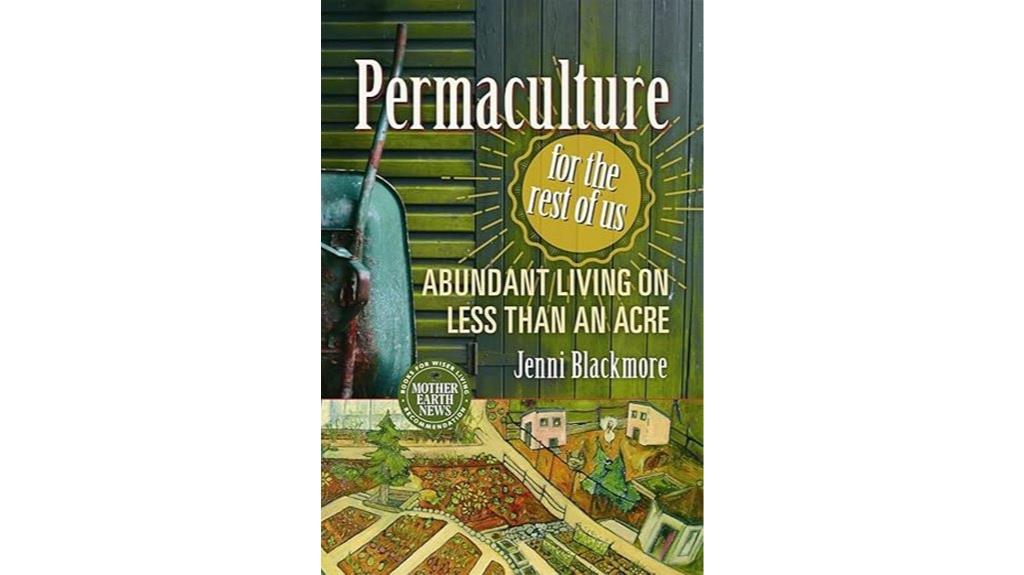
For those looking to maximize their gardening potential in limited space, "Integrating Greenhouses With Your Garden" stands out as the ideal choice. I've found that embracing permaculture principles can transform even the smallest plots into thriving ecosystems. My journey taught me the value of starting small, using techniques like sheet mulching and repurposing tree limbs. It's all about resilience and learning from failures. This lighthearted approach makes permaculture accessible, encouraging anyone to engage, regardless of their experience. Trust me, there's joy in cultivating self-sufficiency, and you won't regret sharing this journey with friends and fellow garden enthusiasts.
Best For: Gardening enthusiasts looking to create sustainable and productive gardens in limited spaces.
Pros:
- Practical Techniques: Offers valuable gardening tips like sheet mulching and repurposing materials, making it accessible for both beginners and experienced gardeners.
- Inspiring Narrative: The author's personal journey and lighthearted writing style motivate readers to engage in permaculture living.
- Flexible Learning: Encourages resilience and continuous learning, allowing readers to develop their own permacultural style without guilt.
Cons:
- Limited Scope: Some readers may find a lack of specific information on livestock and farming practices outside eastern coastal New England.
- Generalized Content: While informative, it may not provide detailed step-by-step guides for every gardening scenario.
- Seasonal Relevance: The book is particularly noted for winter reading, which may not align with all readers' gardening timelines.
VEIKOU 6 x 10 Greenhouse for Outdoors
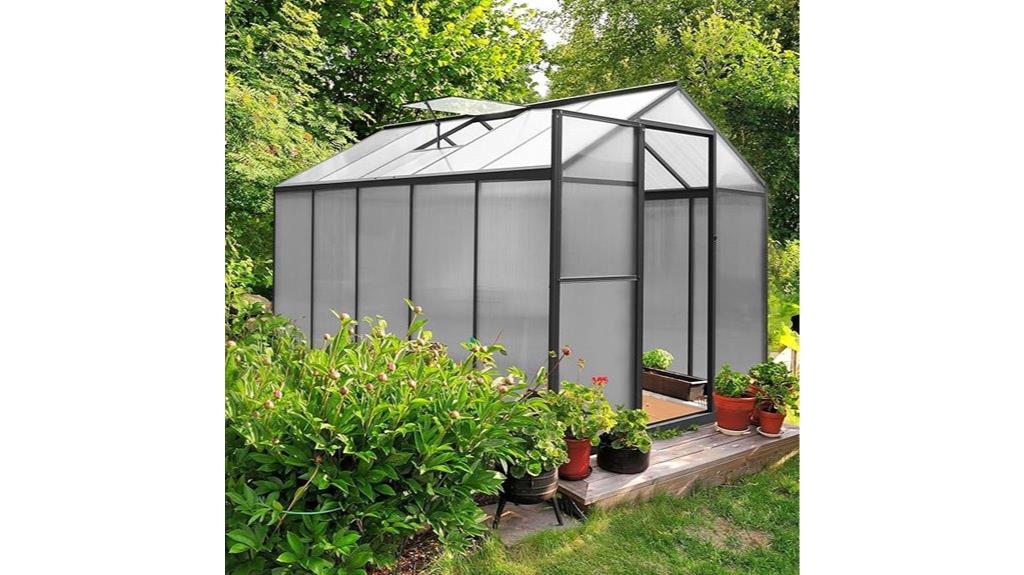
If you're looking for a greenhouse that balances durability with ease of use, the VEIKOU 6 x 10 Greenhouse is an excellent choice for gardeners who want to extend their growing season. With its sturdy aluminum frame and 4mm thick twin-wall polycarbonate panels, it offers superior heat preservation and light transmittance. I appreciate the adjustable vent feature that guarantees fresh air circulation for my plants. Assembly is straightforward thanks to the user-friendly instructions, and I've found it to be a perfect size for my garden. While some users reported minor issues, my overall experience has been positive, making it a worthwhile investment.
Best For: Gardeners looking for a durable and user-friendly greenhouse to extend their growing season.
Pros:
- Sturdy aluminum frame and 4mm thick twin-wall polycarbonate panels provide excellent heat preservation and light transmittance.
- Adjustable vent feature ensures optimal air circulation for healthy plant growth.
- User-friendly assembly instructions make setup quick and straightforward.
Cons:
- Some users have reported minor issues with leaks and broken skylights.
- A few customers found the assembly directions to be unclear.
- Recommendations for DIY panel replacements indicate potential durability concerns.
8×14 FT Green House for Outdoor
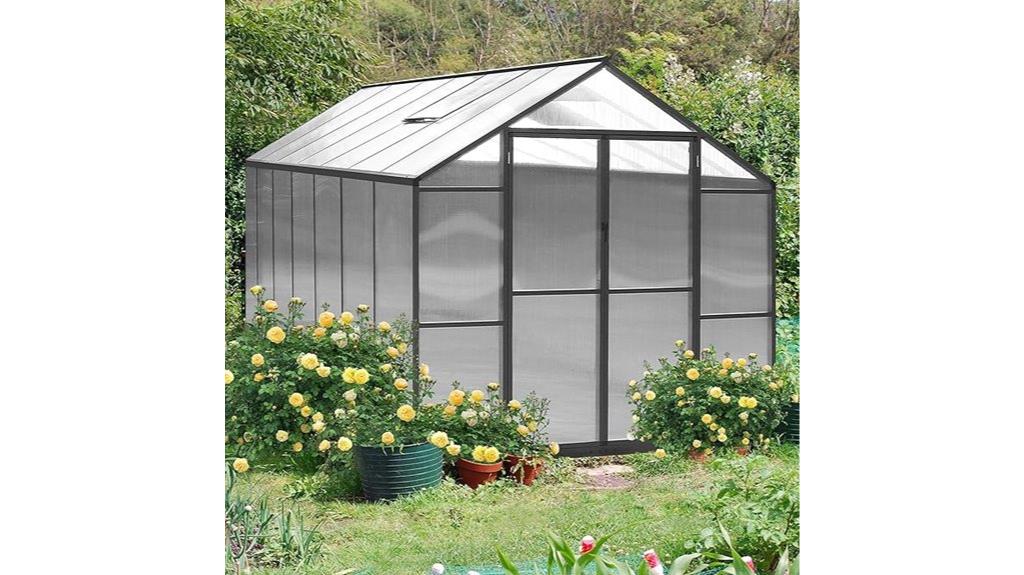
The Yardenaler 8×14 FT Greenhouse is perfect for avid gardeners who want to extend their growing season and cultivate a variety of plants. Its durable aluminum frame and thick polycarbonate panels provide excellent weather resistance, ensuring your plants thrive in any climate. I love the adjustable roof vents that enhance airflow, keeping the environment ideal for growth. Plus, the lockable swing-out door makes it easy to access my gardening tools and supplies. With ample space for flowers, vegetables, and even a play area for kids, this greenhouse truly elevates my gardening experience. It's a fantastic investment for any outdoor space!
Best For: Avid gardeners looking to extend their growing season and cultivate a variety of plants in a durable and spacious greenhouse.
Pros:
- Durable Construction: High-quality aluminum frame and thick polycarbonate panels ensure excellent weather resistance and longevity.
- Adjustable Ventilation: Two adjustable roof vents enhance airflow, creating an optimal environment for plant growth.
- Spacious Design: Ample interior space allows for gardening, storage of tools, and even a recreational area for kids.
Cons:
- Shipping Concerns: The product is shipped in two boxes that may not arrive at the same time, potentially delaying setup.
- Assembly Required: Installation may take time and effort despite the upgraded structure designed for easier assembly.
- Limited Color Options: Available only in gray, which may not suit all aesthetic preferences for outdoor spaces.
6×12 FT Greenhouse Kit for Outdoor
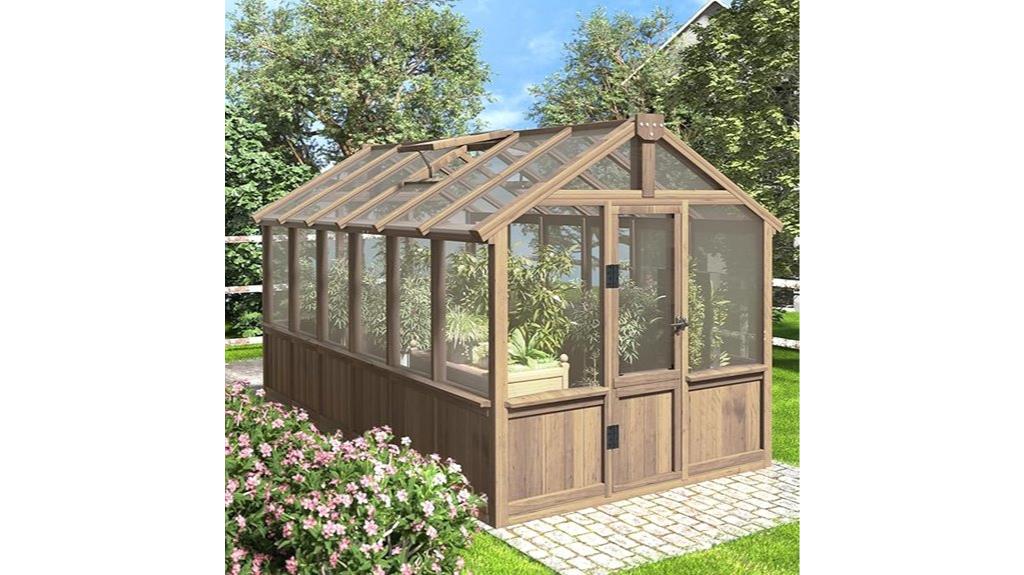
A standout feature of the Yardenaler 6×12 FT Greenhouse Kit is its adjustable roof, allowing you to maximize UV protection and air circulation for your plants. The sturdy wood frame and polycarbonate panels guarantee durability against various weather conditions. With dimensions of 74 W x 143.4 L x 83.5 H, it offers ample space for flowers, vegetables, and even a cozy spot to unwind. Weighing 317 pounds, it's heavy-duty yet aesthetically pleasing. Although assembly is required, many users rate it highly for quality and ease. This greenhouse can truly elevate your garden experience while promoting a thriving ecosystem.
Best For: Garden enthusiasts looking for a durable and spacious greenhouse to cultivate flowers and vegetables while enjoying a relaxing outdoor space.
Pros:
- Sturdy Construction: The heavy-duty wood frame and polycarbonate panels ensure durability against various weather conditions.
- Adjustable Roof: Allows for optimal UV protection and air circulation, promoting healthy plant growth.
- Versatile Use: Provides ample space for gardening and can double as a storage area for tools or a cozy relaxation spot.
Cons:
- Assembly Required: The greenhouse requires assembly, which may be challenging for some users.
- Vent Design Concerns: Some users have reported issues with the roof vent design, indicating potential room for improvement.
- Weight: At 317 pounds, it may be difficult to move once assembled, limiting placement options.
CDCASA 12.4×6.2 FT Greenhouse for Outdoors
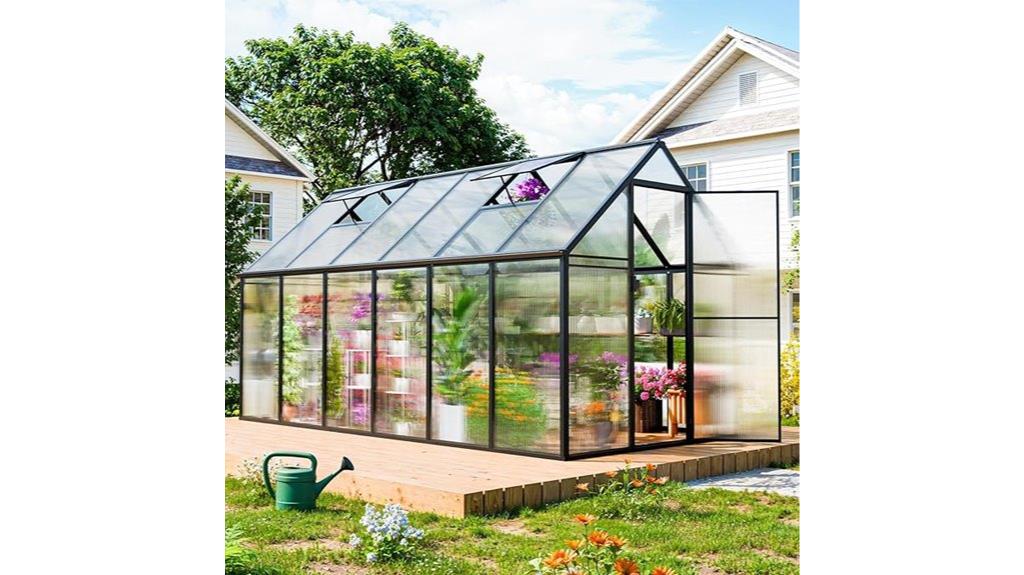
For gardeners seeking a robust solution to extend their growing season, the CDCASA 12.4×6.2 FT Greenhouse stands out with its durable aluminum frame and twin-wall polycarbonate panels. Measuring 148.2 x 74.8 x 79.9 inches, it's perfect for patios, backyards, and gardens. I love its 70% light transmission while blocking harmful UV rays. Assembly can take 4-6 hours, but the Quick Connect system makes it easier. With adjustable window vents and rain gutters, it guarantees proper air circulation and drainage. Although some users mention assembly challenges, the overall value and durability make it a great addition to any gardening setup.
Best For: Gardeners looking for a durable and spacious greenhouse to extend their growing season in outdoor settings.
Pros:
- Durable construction with a thicker aluminum frame and twin-wall polycarbonate panels.
- Quick Connect assembly technology reduces setup time by 50%.
- Adjustable window vents and rain gutters enhance air circulation and drainage.
Cons:
- Some users report unclear assembly instructions leading to difficulties.
- Occasional shipping damages noted by customers.
- Misalignment of parts during assembly can be a common issue.
Factors to Consider When Choosing to Integrate Greenhouses With Gardens

When I think about integrating a greenhouse with my garden, I consider several key factors. Size and space requirements, climate conditions, and the materials used all play a vital role in making the right choice. Plus, I can't overlook the importance of ventilation and how easy it is to maintain the setup.
Size and Space Requirements
Choosing the right size for your greenhouse is essential to successfully integrating it into your garden. I always start by considering the dimensions of the available space; the greenhouse should fit comfortably without crowding other plants or structures. It's important to assess the height, too, ensuring it accommodates taller plants while allowing for proper ventilation and light. I also make sure there's enough walking space around the structure for maintenance and harvesting without damaging nearby plants. Accessibility is key, so I pay attention to door sizes and pathways for easy movement of tools and supplies. Finally, I think about future gardening ambitions—opting for a slightly larger greenhouse can open up possibilities for new plant varieties or seasonal crops.
Climate and Weather Conditions
Understanding the local climate and weather conditions is vital for successfully integrating a greenhouse into your garden. I've learned that the effectiveness of a greenhouse is influenced by temperature fluctuations; areas with drastic changes may need extra insulation or heating to protect sensitive plants. It's also important to take into account regional weather patterns, like rainfall and wind intensity, to choose the right materials and guarantee structural stability. In humid climates, I've found that good ventilation prevents mold, while arid regions benefit from misting systems to maintain humidity. Finally, seasonal changes dictate not only which crops to grow but also design features like adjustable vents for airflow and shading options to manage excessive sunlight.
Material and Durability
The materials you select for your greenhouse play an essential role in its durability and overall effectiveness within your garden. I've found that aluminum frames paired with polycarbonate panels offer excellent rust resistance and let in plenty of light, promoting ideal plant growth. Thicker polycarbonate panels, like 4mm twin-wall construction, are fantastic for heat preservation and block over 99.9% of harmful UV rays, ensuring a safe environment for your plants. Choosing a thicker aluminum alloy for the frame guarantees stability through various weather conditions, perfect for year-round gardening. Plus, greenhouses with rust-resistant coatings and lightweight materials make transport and assembly a breeze while maintaining strength. Integrating features like adjustable vents enhances both durability and functionality.
Ventilation and Airflow Needs
While integrating a greenhouse into your garden, it's essential to prioritize proper ventilation and airflow. I've learned that maintaining ideal temperature and humidity levels is crucial for healthy plant growth and disease prevention. Adjustable vents are a game changer, allowing me to customize airflow based on the needs of my crops. By increasing airflow, I can greatly reduce the risk of mold and mildew, which can harm my plants. I also focus on the strategic placement of vents and windows to enhance natural ventilation, creating cross-breezes that cool the greenhouse on hot days. Monitoring airflow and adjusting ventilation as needed has really influenced my plants' growth rates and overall yield, making it necessary for a successful integration.
Accessibility and Maintenance Ease
When integrating a greenhouse with my garden, I've found that accessibility and maintenance ease are key factors to contemplate. Ensuring I can easily move around for planting, maintenance, and harvesting makes a huge difference. I've learned to design pathways and entry points that allow for simple navigation, reducing the physical strain of upkeep. Incorporating raised beds adjacent to the greenhouse has also been a game changer, as they minimize bending and reaching. Additionally, I've installed adjustable vents and removable panels, which simplify cleaning and improve airflow. These thoughtful choices not only make my gardening tasks easier but also create a more enjoyable experience, allowing me to focus on nurturing my plants rather than struggling with accessibility challenges.
Plant Compatibility and Growth
Choosing the right plants for your greenhouse can feel overwhelming, but it's essential for achieving healthy growth and maximizing your garden's potential. I've learned that compatibility directly affects growth rates, yield, and overall health. Different plants have unique light, temperature, and humidity needs, so grouping compatible species together really boosts their growth. I've also found that crop rotation and companion planting can enhance soil health and keep pests at bay, further supporting plant compatibility. By understanding the specific requirements of vegetables, fruits, herbs, and flowers, I can make the most of my space and resources. Ultimately, I regularly monitor plant health and environmental conditions to tackle any compatibility issues that pop up during the growing season.
Aesthetic Integration With Landscape
Integrating a greenhouse into your garden can transform your outdoor space, creating a harmonious blend of functionality and beauty. I've found that choosing a design that complements existing landscape features is essential. Using materials and colors that harmonize with surrounding plants helps create a cohesive look. Opting for a hexagonal or uniquely shaped greenhouse adds visual interest, breaking the monotony of traditional layouts. Incorporating natural elements like trellises or green walls makes the greenhouse feel like an integral part of the landscape. Strategic placement is key, as it maximizes sunlight while considering its visual impact from various viewpoints. Utilizing transparent materials enhances light penetration and connects the greenhouse to the garden environment, enriching the overall aesthetic experience.
Budget and Cost Considerations
Budgeting for a greenhouse can feel overwhelming, especially when considering all the factors involved. I've learned that the initial setup costs can vary greatly based on size and design, so I always start by researching materials and construction options. If you're like me, you might find that purchasing a greenhouse kit can save money since it includes pre-cut materials and assembly instructions. Don't forget to factor in ongoing expenses like heating, cooling, and maintenance, as they can add up over time. I also recommend budgeting for features like ventilation and irrigation systems to enhance functionality. Finally, remember that increased crop yields and longer growing seasons can offset that initial investment, making it a worthwhile consideration.
Frequently Asked Questions
How Can I Attract Beneficial Insects to My Greenhouse Garden?
To attract beneficial insects to my greenhouse garden, I've found that planting a variety of flowering herbs like dill and parsley works wonders. I also leave some areas slightly wild with native plants to create a welcoming habitat. I avoid using pesticides, which can deter these helpful critters. Finally, I make sure to provide water sources, like shallow dishes, to keep them around. It's all about creating a friendly environment!
What Plants Are Best Suited for Greenhouse Integration With Outdoor Gardens?
When I first started integrating my greenhouse with my outdoor garden, I found that tomatoes thrived best in both environments. These plants love warmth and can benefit from the controlled climate inside the greenhouse while also flourishing outdoors. I've noticed that growing herbs like basil alongside them enhances their flavor and attracts beneficial insects. Experimenting with companion planting has transformed my garden into a vibrant ecosystem, making it both productive and beautiful.
How Do I Manage Pests in a Greenhouse Environment?
Managing pests in a greenhouse can be tricky, but I've found some effective strategies. First, I keep a close eye on my plants, regularly checking for any signs of trouble. I also introduce beneficial insects, like ladybugs, which help control pests naturally. Using organic insecticides is another option I rely on when needed. Additionally, maintaining good airflow and cleanliness in the greenhouse makes a big difference in preventing infestations.
Can I Use My Greenhouse for Year-Round Gardening?
Did you know that nearly 50% of greenhouse owners successfully grow crops year-round? Absolutely, you can use your greenhouse for year-round gardening! I've found it's a fantastic way to extend the growing season and enjoy fresh produce even in winter. By managing temperature and humidity, I can create an ideal environment for various plants. Plus, experimenting with different crops throughout the year has made my gardening experience even more rewarding.
What Are the Best Watering Techniques for Greenhouse Plants?
When it comes to watering my greenhouse plants, I've found that drip irrigation works wonders. It delivers water directly to the roots, minimizing waste and reducing the risk of disease. I also use a moisture meter to avoid overwatering. Misting my plants during the hottest parts of the day helps maintain humidity too. I've learned that timing and technique are essential for keeping my greenhouse thriving, so I always stay attentive to their needs.
Conclusion
Integrating a greenhouse with your garden can transform it into a lush paradise, bursting with vibrant plants and bountiful harvests. Imagine stepping into a world where fresh herbs, organic vegetables, and colorful flowers thrive side by side, all thanks to your thoughtful design. By following the tips and tools outlined here, you can create a harmonious ecosystem that not only enhances your garden but also makes it the envy of your neighborhood. Happy gardening!


